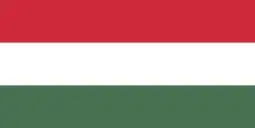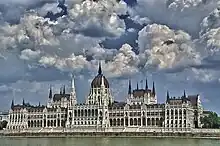Hungarian nationalism
Hungarian nationalism developed in the late 18th century[1][2] and early 19th century along the classic lines of scholarly interest leading to political nationalism and mass participation.[3][4] In the 1790s, Hungarian nobles pushed for the adoption of Hungarian as the official language rather than Latin.[1][2]
Parties
Former (After 1989: End of communism in Hungary)
- People of the Orient Party – Christian Democrats[10] (1989–1998)
- Party of the Hungarian Interest[11] (1993–2005)
- Hungarian Justice and Life Party[12] (1993–2021) merged with Our Homeland Movement [13]
Former (Before 1945)
- Unity Party (1922–1944)
- Hungarian National Independence Party (1923-1928)
- Hungarian National Socialist Agricultural Labourers' and Workers' Party[14][15] (1932–1945)
- Arrow Cross Party[16] (1935–1945)
- Christian National Socialist Front[17] (1937–1940)
- United Hungarian National Socialist Party[18] (1936–1940)
- National Front[17] (1936-1939)
Movements
- Magyar Gárda (2007-2009), see also Magyar Nemzeti Gárda
- Force and Determination[19] (2017–present)
- Sixty-Four Counties Youth Movement[20] (2001–present)
- Pax Hungarica Movement[21][22] (2008–2017)
- Hungarian National Defence Association or "Véderő"[23] (2007-2011)
- Hungarian National Front[24][25] (1989-2016)
- Civil Guard Association for a Better Future[26] (2011-present)
- Magyar Nemzeti Gárda[27] (2010-present)
- Betyársereg[28]
- Legio Hungaria[29]
See also
References
- Almási, Gábor; Šubarić, Lav (2022). "The new discourses of nation: The origins of nationalism in late eighteenth‐century Hungary (Part 1)". Nations and Nationalism. 28 (3): 894–908. doi:10.1111/nana.12827. ISSN 1354-5078. S2CID 248717936.
- Almási, Gábor; Šubarić, Lav (2022). "The new discourses of nation: The origins of nationalism in late eighteenth‐century Hungary (Part 2)". Nations and Nationalism. 28 (4): 1326–1339. doi:10.1111/nana.12826. ISSN 1354-5078. S2CID 248709263.
- Hoolihan, Mark James (2007). Mark James Hoolihan, p. 17, 2007. ISBN 9780549238607.
- Colquhoun, A. R., & Colquhoun, E. M. C. (1914). The whirlpool of Europe, Austria-Hungary and the Habsburgs. New York: Dodd, Mead.
- Ilikova, Lilia; Tushev, Andrey (2020). "Right-Wing Populism in Central Europe: Hungarian Case (Fidesz, Jobbik)". redalyc.org. Retrieved 6 September 2023.
- Palonen, Emilia (25 July 2018). "Performing the nation: the Janus-faced populist foundations of illiberalism in Hungary". Taylor&Francis online. Retrieved 6 September 2023.
- "Europe and right-wing nationalism: A country-by-country guide". BBC News. 2016-04-27. Retrieved 2023-09-06.
- "ECHR upholds ban on Hungarian far-right group". Euronews.com. euronews. 9 July 2013.
- Haines, John R. (10 July 2018). "/A New Political Movement Emerges on Hungary's Far Right". Fpri.org. FPRI.
- Vida, István (2011). "Kelet Népe Párt, Kereszténydemokraták (KNP–KD)". Magyarországi politikai pártok lexikona (1846–2010) [Encyclopedia of the Political Parties in Hungary (1846–2010)] (in Hungarian). Gondolat Kiadó. pp. 365–366. ISBN 978-963-693-276-3.
- Vida, István (2011). "A Magyar Érdek Pártja (AMÉP)". Magyarországi politikai pártok lexikona (1846–2010) [Encyclopedia of the Political Parties in Hungary (1846–2010)] (in Hungarian). Gondolat Kiadó. p. 334. ISBN 978-963-693-276-3.
- The Hungarian Patient: Social Opposition to an Illiberal Democracy Hardcover – July 2, 2015 by Peter Krasztev (Author, Editor), Jon Van Til (Editor), p. 134.
- "Kuruc.info - Megszűnt a MIÉP, felszámolási eljárásban az FKGP - vezetőik a Mi Hazánk jelöltjei lettek".
- Sipos, Péter (1979). "Nyilasmozgalmak,1931–1944". História. 1 (04): 44.
- "Hungarian nationalism" (PDF). Oszk.hu. Retrieved September 8, 2019.
- "Hungarian Nazis (Arrowcross Party)". Terrorhaza.hu.
- Dieter Nohlen & Philip Stöver (2010) Elections in Europe: A data handbook, p911 ISBN 978-3-8329-5609-7
- Paksy Zoltán - A nemzetiszocialista mozgalmak megszerveződése, párt- és regionális struktúrája Magyarországon az 1930-as években, Múltunk 2003/3 p. 202-237.- (Zoltán Paksy - The organization, party and regional structure of the national socialist movements in Hungary in the 1930s)
- "Hungarian far right launches new political party". The Guardian. 8 July 2017. Retrieved 20 September 2018.
- "Hungarian far-right figure attacked in Serbia". politics.hu. Archived from the original on 2014-10-26. Retrieved 2015-01-04.
- "Elfogytak a tagok: megszűnik a Pax Hungarica Mozgalom" (in Hungarian). Mandiner. 2017-07-31. Retrieved 2017-08-09.
- Mareš, Miroslav; Laryš, Martin; Holzer, Jan (October 25, 2018). Militant Right-Wing Extremism in Putin's Russia: Legacies, Forms and Threats. Routledge. ISBN 9780429953620 – via Google Books.
- "Jobbik deputy chairman slams Véderő head; party seen favoring crackdown on controversial civil guard group". politics.hu. Archived from the original on 24 September 2015. Retrieved 11 November 2011.
- Szemán, László János (8 December 2017). "Felszámolták a szélsőséges hungarista szervezetet". Magyar Idők (in Hungarian). Retrieved 16 January 2017.
- Kovács, Zsóka (12 March 2018). "Prosecutor's office presses charges against Hungarian National Front". dailynewshungary.com. Dailynews Hungary.
- "Hungarian Government Urged To Protect Roma From Harassment and Intimidation". Human Rights First. 2011-03-18. Archived from the original on 2011-04-08. Retrieved 2011-03-28.
- 4News
- 4News
- rcc.int
Further reading
- Maxwell, Alexander (2005). "Multiple Nationalism: National Concepts in Nineteenth-Century Hungary and Benedict Anderson's "Imagined Communities". Nationalism and Ethnic Politics. Nationalism and Ethnic Politics, Volume 11, Issue 3. 11 (3): 385–414. doi:10.1080/13537110500255619. S2CID 144921927.
This article is issued from Wikipedia. The text is licensed under Creative Commons - Attribution - Sharealike. Additional terms may apply for the media files.


.svg.png.webp)